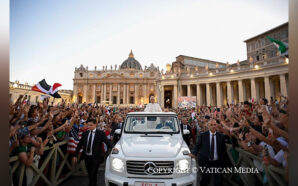On May 9, 2024, the Solemnity of the Ascension, Pope Francis published the Bull of Indiction for the Ordinary Jubilee of the Year 2025, Spes non confundit. This is the XXXI Jubilee,[1] following the first one proclaimed by Boniface VIII in 1300. The title is a quotation from the letter to the Romans, “Hope does not disappoint,” because it offers the certainty of God’s love (cf. Rom 5:5) (no. 1).[2]
Francis begins with the wish that the Holy Year “may be for all an opportunity to be renewed in hope” (no. 1). The Jubilee opens in a dimension of universal evangelization, for everyone. It goes beyond ecclesial boundaries because “in the heart of each person, hope dwells as the desire and expectation of good things to come, despite our not knowing what the future may bring” (ibid.). If life is made up of joys and sorrows, trials and difficulties, and if hope seems to crumble in the face of suffering, Paul, shockingly, writes, “We also boast in our sufferings, knowing that suffering produces endurance, and endurance produces character, and character produces hope (Rom. 5:3-4)” (no. 4). Here “endurance,” coupled with hope, is holding fast in trials, not being discouraged, persevering, not being in a hurry in a time when we are used to wanting everything and everything now.
That path that is life
From this interweaving of “hope” and “endurance,” emerges the Christian life as “a journey,” the sign of which is pilgrimage, “traditionally associated with our human quest for meaning in life” (no. 5). It is a journey that requires strength to be nourished and hardened to give us a glimpse of the goal, “the encounter with the Lord Jesus” (ibid.). Such an encounter guides the pilgrims who will come to Rome and those who will visit the Jubilee churches to celebrate the Holy Year.
Throughout history, many times the grace of forgiveness has been given to the faithful in a new and special way, the “pardon” of Celestine V in 1294, and even earlier, in 1216, the Jubilee grace requested by St. Francis from Honorius III for the Portiuncula, as well as that of 1122 from Callistus II for the pilgrimage to Santiago de Compostela (cf. ibid.). At first the Jubilee fell every 100 years, which was later reduced to 50 in 1343 by Clement VI and to 25 in 1470 by Paul II. There have also been extraordinary Jubilees: in 1933, the one called by Pius XI for the anniversary of the Redemption and taken up again in 1983 by John Paul II; in 2015, Francis’ Jubilee to encounter God’s “Face of Mercy” on the 50th anniversary of Vatican II.
Such events involved the “pilgrimage” to Rome to venerate the apostles’ tombs in the Basilicas of St. Peter and St. Paul. In 1350, the Basilicas of the Lateran, St. Mary Major and St Lawrence Outside-the-Walls[3] were also added. Later, another sign was inserted, that of the Holy Door, established perhaps by Sixtus IV or Alexander VI. Such a “door of salvation” indicates a living and personal encounter with Christ (cf. John 10:7,9).[4]
The Holy Year of 2025 enjoys some special features. While standing in continuity with previous Jubilees, this time it falls on the anniversary – 1700 years – of the celebration of the first Ecumenical Council of Nicaea in 325, “a milestone in the history of the Church [which] had the task of preserving unity, which was seriously threatened by the denial of the full divinity of Jesus Christ and hence his consubstantiality with the Father” (no. 17). The Council also dealt with the dating of Easter. By a providential coincidence, in 2025 the date of this holiday will fall on the same day for all Christians, April 20. The pope hopes it will be a general invitation to take a decisive step toward unity by establishing a common date for the solemnity. The Holy Year also coincides with the anniversary – on November 9, 2024 – of the 17 centuries of the Basilica of St. John Lateran, the cathedral of the Bishop of Rome, and at the same time looks toward 2033, when “the two thousandth anniversary of the redemption won by the passion, death and resurrection of the Lord Jesus” (no. 6) will be celebrated.
This Jubilee begins with the opening of the Holy Door of St. Peter’s Basilica on December 24 and will close on Epiphany 2026.[5] The pope also decrees that on Sunday, December 29, 2024, in all cathedrals, diocesan bishops will celebrate the Eucharist as the solemn opening of the Holy Year with the announcement of the Jubilee Indulgence.[6]
The Proclamation and Signs of Hope
A novelty of the Bull consists in presenting together the proclamation of hope with the signs that make it clear and relevant with a reference to Gaudium et Spes: “The Church has always had the duty of scrutinizing the signs of the times and of interpreting them in the light of the Gospel.”[7] The signs of the times, which reveal the aspiration of the human heart in need of salvation, must therefore be transformed into acts that keep hope alive and tangible.
The first must be “peace in our world, which once more finds itself immersed in the tragedy of war. Heedless of the horrors of the past, humanity is confronting yet another ordeal, as many peoples are prey to brutality and violence” (no. 8). The pope wonders apprehensively whether it is too much to dream that weapons will fall silent and no longer bring destruction and death. “May the Jubilee remind us that those who are peacemakers will be called ‘children of God’ (Matt 5:9)” (ibid.). There should be no lack of diplomatic efforts to build lasting peace.
The second palpable sign of hope is “enthusiasm for life and a readiness to share it” (no. 9). Today we see in our world the “loss of the desire to transmit life” (ibid.), with a disturbing decline in the birth rate. Sadly, the misunderstanding of those who “blame population growth instead of extreme and selective consumerism on the part of some, [which] is one way of refusing to face the issues”[8] should be pointed out. All believers and civil society as a whole have the task of witnessing to the fruitfulness of love, “the desire of young people to give birth to new sons and daughters” to give a future to their society: “This is a matter of hope: it is born of hope, and it generates hope” (ibid.). Let the Christian community support “the need for a social covenant to support and foster hope, […] for a future filled with the laughter of babies and children” (ibid.)
The third manifestation of hope concerns brothers and sisters living in conditions of hardship. The pope mentions “prisoners who, deprived of their freedom, daily feel the harshness of detention and its restrictions, lack of affection and, in more than a few cases, lack of respect for their persons” (no. 10). It would be desirable to provide for them initiatives of hope such as forms of amnesty, remission of punishment, paths of reintegration into society, and respect for human rights.
Unfortunately, the death penalty still exists in some countries. Believers, and first and foremost bishops, should work to abolish it. It is contrary to the Christian faith and destroys all hope. The Bull recalls that Scripture, in announcing the Jubilee, proclaims “liberty throughout the land to all its inhabitants” (Lev 25:10) (ibid.). Jesus himself, at the beginning of his ministry in Nazareth, echoed the prophet Isaiah: “He has sent me to bring good news to the oppressed, to bind up the brokenhearted, to proclaim liberty to the captives, and release to the prisoners; to proclaim the year of the Lord’s favor (Isa 61:1-2).”[9] To offer a sign of compassion for prisoners, Francis wishes to open a Holy Door in a prison, so that it may be a striking sign of hope and a commitment to life.[10]
Another gesture is to be offered to the sick who are in our homes or hospitals, reflected in the closeness of people visiting them and may the affection they receive alleviate their suffering, since works of mercy are also works of hope. Moreover, caring for them is “a hymn to human dignity” (no. 11).
Young people also need to be supported to have confidence, as they often see their dreams fade away. It is gratifying to observe them enthusiastic when they engage in volunteer work in situations of calamity or social hardship, but it is sad to see them discouraged. “Escaping into drugs, risk-taking and the pursuit of momentary pleasure does greater harm to them in particular, since it closes them to life’s beauty and richness” (no. 12). May the Jubilee in the Christian community promote a renewed passion to care for young people, students, and engaged couples. They are the future and the hope of the world and the Church.
There should be no lack, again, of signs of closeness and welcome for migrants, exiles, refugees and displaced persons, who leave their land to flee wars, violence, discrimination, in search of a better future. Above all, the Christian community should always be ready to defend the right of the weakest, according to the words of the Lord: “Just as you did it to one of the least of these my brothers and sisters, you did it to me (Matt 25:35, 40)” (no. 13).
Finally, Francis calls for gestures that express support and closeness toward the elderly, who are often alone and abandoned, thus opening them up to hope; especially toward grandfathers and grandmothers, “who represent the passing on of faith and wisdom to the younger generation” (no. 14). Above all, he urges such gestures “for the billions of poor who often lack the essentials of life. […] Often they are homeless or lack sufficient food for the day. They suffer from exclusion and indifference on the part of many” (no. 15). And they are almost always victims through no fault of their own.
Calls for Hope
On the occasion of the Jubilee, Francis makes two appeals to those who influence the fate of humanity. The first is to attempt to eliminate hunger in the world, since “hunger is a scandal, an open wound on the body of our humanity, and it summons all of us to a serious examination of conscience” (no. 16), recalling that the goods of the Earth are not for a privileged few, but for all. In particular, he renews a heartfelt call that “with the money spent on weapons […] let us establish a global fund that can finally put an end to hunger and favor development in the most impoverished countries” (ibid.).[11]
The second appeal is addressed to rich nations and concerns international debt. Rich countries should “determine to forgive the debts of countries that will never be able to repay them” (ibid.). The pope notes, “More than a question of generosity, this is a matter of justice. It is made all the more serious today by a new form of injustice which we increasingly recognize, namely, that a true ‘ecological debt’ exists, particularly between the global North and South, connected […] to the disproportionate use of natural resources by certain countries over long periods of time” (ibid.).[12] As Leviticus teaches, the Earth belongs to God and we all inhabit it as “aliens and tenants” (Lev 25:23). This is a fundamental issue if we are to prepare a way in the world to restore peace.
Hope Directs Life
The central part of the Bull leads us to reflect on the goal of our hope. Hope “is founded on faith and nurtured by charity” (no. 3). The three theological virtues enunciate the essence of the Christian life (cf. no. 18), but the first reflects the orientation of the believer’s life toward “eternal life as our happiness” (no. 19). Our faith professes this: “I believe in life everlasting” (ibid.). The constitution Gaudium et Spes confirms: if the hope of the future life is lacking, “human dignity is most grievously lacerated, […] and the riddles of life and death, of guilt and of grief go unsolved.”[13] “We, however, by virtue of the hope in which we were saved, can view the passage of time with the certainty that the history of humanity and our own individual history are not doomed to a dead end or a dark abyss, but directed to an encounter with the Lord of glory” (ibid.).
Francis pauses on the big questions that arise in us when confronted with the death of loved ones, where everything seems to end in nothingness. The apostle Paul invites us to look to the Lord, “Christ died for our sins in accordance with the scriptures, and that he was buried, and that he was raised on the third day” (cf. 1 Cor 15:3-5). Where Christ has died for us, there is the assurance that, through him and the gift of baptism, “life is not taken away, but transformed,” forever.[14]
The most vivid witness to this hope is given by the martyrs, who, through faith in Christ, were able to give up their lives to be faithful to the Lord. They have always been present in the history of the Church and are numerous even in our days. What is more, they belong to different Christian traditions and thus even become “seeds of unity, expressions of the ecumenism of blood” (no. 20). It is the pope’s fervent wish that during the Jubilee an ecumenical celebration will commemorate them.
Hence the question, “What, then, will become of us after death? With Jesus, beyond this threshold we will find eternal life, consisting in full communion with God as we forever contemplate and share in his infinite love” (no. 21).[15] “What will characterize this fullness of communion? Being happy. Happiness is our human vocation, a goal to which all aspire” (ibid.).
But what happiness? From experience, we all feel that we are happy when we are loved: “I am loved, therefore I exist; and I will live forever in the love that does not disappoint, the love from which nothing can ever separate me” (ibid.). The apostle confirms this: “Neither death nor life, nor angels nor rulers, […] nor anything else in all creation, will be able to separate us from the love of God in Christ Jesus our Lord (Rom 8:38-39)” (ibid.).
The Last Judgment and the Jubilee Indulgence
With eternal life is connected God’s judgment, both at the end of personal life and at the end of time. The judgment of a merciful God, “who is love (cf. 1 John 4:8.16), will surely be based on love, and in particular on all that we have done or failed to do with regard to those in need, in whose midst Christ, the Judge himself, is present (cf. Matt 25:31-46)” (no. 22). The judgment is about salvation, which Jesus obtained for us through his death and resurrection.
“The evil we have done cannot remain hidden; it needs to be purified in order to enable this definitive encounter with God’s love. Here we begin to see the need of our prayers for all those who have ended their earthly pilgrimage, our solidarity in an intercession that is effective by virtue of the communion of the saints, and the shared bond that makes us one in Christ, the firstborn of all creation. The Jubilee indulgence, thanks to the power of prayer, is intended in a particular way for those who have gone before us, so that they may obtain full mercy” (no. 22). It is therefore a responsibility that engages all believers to communicate God’s indulgence and mercy.[16]
The perspective in which Francis places the indulgence echoes the novelty that characterized the previous Jubilee of Mercy: it is based “on the communion of saints.”[17] For such communion “Mother Church is able by her prayer and her life to meet the weakness of some with the holiness of others.”[18] Indulgence then is not a gain (“a profit”), but rather consists in “experiencing the holiness of the Church which participates in all the benefits of Christ’s redemption.”[19]
The concept is taken up with more insistence on the Lord’s infinite mercy: “Indeed, the indulgence is a way of discovering the unlimited nature of God’s mercy. Not by chance, for the ancients, the terms “mercy” and “indulgence” were interchangeable, as expressions of the fullness of God’s forgiveness, which knows no bounds” (no. 23).
The originality of this Jubilee, which does not consider the question of indulgences, but divine forgiveness, cannot be missed. Francis does not place at the foot of the Bull the Dispositions for the acquisition of the Jubilee indulgence.[20] This is a significant change in perspective.
The Sacrament of Penance
This is followed by an exhortation to rediscover the beauty of the sacrament of Penance, which assures us of forgiveness: “God wipes away our sins” (no. 23). Appropriately, Psalm 103 is recalled: “The Lord is merciful and gracious, slow to anger and abounding in steadfast love. […] He does not deal with us according to our sins, nor repay us according to our iniquities. For as the heavens are high above the earth, so great is his steadfast love toward those who fear him” (Psalm 103:8,10,11). Reconciliation in the sacrament is essential for our journey of faith, conversion, and communion with the Lord: “There is no better way to know God than to let him reconcile us to himself (cf. 2 Cor 5:20)” (ibid.).
However, it is also specified that every sin “leaves its mark.” It carries with it consequences and, even if venial, “entails an unhealthy attachment to creatures, which must be purified either here on earth, or after death, in the state called Purgatory” (no. 23). It should be noted that this passage is a quotation from the Catechism of the Catholic Church, where, however, purification from “so-called ‘temporal punishment’” is mentioned, which is omitted here.[21] There is a qualitative leap concerning the definition of “indulgence,” now qualified as God’s mercy. Regarding “the residues of sin,” it is stated that “these are removed by the indulgence, always by the grace of Christ, who, as Saint Paul VI wrote, “is himself our ‘indulgence’” (ibid.).[22]
On forgiveness, the Bull offers a singular key: “Forgiveness does not change the past; it cannot change what happened in the past, yet it can allow us to change the future and to live different lives, free of anger, animosity and vindictiveness. Forgiveness makes possible a brighter future, which enables us to look at the past with different eyes, now more serene, albeit still bearing the trace of past tears” (ibid.).
Finally, the pope reconfirms the Missionaries of Mercy, already established in the previous Jubilee, so that they may bring divine forgiveness to where hope is put to the test: to prisons, hospitals, and places where the dignity of the person is violated.
The Conclusion and Logo of the Jubilee: ‘Anchored in Hope’
The conclusion of the document is a pressing invitation to listen to God’s word, which is addressed to us on our way to the Jubilee. Having sought a refuge in the Lord, “we have this hope, a sure and steadfast anchor of the soul, a hope that enters the inner shrine behind the curtain, where Jesus, the forerunner on our behalf, has entered (Heb 6:18-20)” (no. 25).
The image of the anchor is suggestive and is echoed in the Jubilee logo. Four stylized figures indicate humanity from the four corners of the earth. They embrace, one with another, to indicate the solidarity and fraternity that should unite peoples. The first figure is clinging to the cross of Christ, a sign of hope and an anchor of salvation. Below the figures are waves, which are moved to indicate the pilgrimage of life that does not always take place in calm waters. This is why the lower part of the cross turns into an anchor, a sign of stability. It indicates the hope that opposes the wave motion and the salvation that comes from the Lord. Finally, around the logo is the date of the Jubilee and the motto, Peregrinantes in spem “Pilgrims of hope.”
The Bull concludes with a prayer to Our Lady: “Hope finds its supreme witness in the Mother of God. In the Blessed Virgin, we see that hope is not naive optimism but a gift of grace amid the realities of life” (no. 24). It recalls Simeon’s prophecy that a sword would pierce her soul (cf. Luke 2:34-35) and her presence at the foot of the cross: “In the travail of that sorrow, offered in love, Mary became our Mother, the Mother of Hope” (ibid.). Francis recalls the Virgin’s first apparition, in 1531 in Mexico City, to young Juan Diego, one of the first Aztec converts to Christianity, with a message of hope, which he repeats to all pilgrims today, “Am I not here, who am your Mother?” (no. 24).
In his letter to Archbishop Rino Fisichella, who is in charge of the Jubilee,[23] the Holy Father recommends living 2024, which precedes the Holy Year, as “an intense year of prayer, making the ‘Our Father,’ […] the life program of every one of his disciples.”[24]
Francis has written the following Jubilee Prayer:
Father in heaven, may the faith you have given us in your Son, Jesus Christ, our brother, and the flame of charity enkindled in our hearts by the Holy Spirit, reawaken in us the blessed hope for the coming of your Kingdom.
May your grace transform us into tireless cultivators of the seeds of the Gospel. May those seeds transform from within both humanity and the whole cosmos in the sure expectation of a new heaven and a new earth, when, with the powers of Evil vanquished, your glory will shine eternally.
May the grace of the Jubilee reawaken in us, “Pilgrims of Hope,” a yearning for the treasures of heaven. May that same grace spread the joy and peace of our Redeemer throughout the earth. To you our God, eternally blessed, be glory and praise for ever. Amen.
Reproduced with permission from La Civiltà Cattolica.
[1]. “Jubilee” is derived from the Hebrew jôbḗl, meaning the ram’s horn used in the Temple in Jerusalem as a trumpet to announce the Day of Atonement (Yom Kippur). This occasion takes on a special significance every 50 years: the jubilee year (shenàt hajôbḗl: cf. Lev 25:13). After “seven weeks of years, that is, seven times seven years,” the 50th was “the Jubilee” (v. 11). It involved a general liberation of persons and property, so that each person regained possession of his or her property (v. 10) and slaves regained their freedom. Although difficult to accomplish, Jubilee was an opportunity to restore the proper relationship with God, with people and involved the remission of debts and rest for the land. In the Old Testament – historians document – it seems that Jubilee, though representing an ideal of justice, was never realized (cf. R. de Vaux, Le Istituzioni dell’Antico Testamento, Turin, Marietti, 1964, 182-184). The term “jubilee” does not occur in the New Testament, but Jesus alludes to it in Nazareth when he begins his ministry: cf. Luke 4:18-22.
[2]. The numbers in parentheses in the text indicate the paragraphs of the Bull Spes non confundit. The text can be found at https://www.vatican.va/content/francesco/en/bulls/documents/20240509_spes-non-confundit_bolla-giubileo2025.html
[3]. Cf. A. Melloni, Il giubileo. Una storia, Bari – Rome, Laterza, 2015, 38-54.
[4]. Jesus proclaims in front of the Sheep Gate, one of the entrances into the Temple, “I am the door of the sheep.” The formula indicates not only “the door” as the way to reach God, but the living Temple in which one reaches the Lord Jesus (cf. G. Ravasi, Giubileo. Il grande sabato, Milan, Mondadori, 2020, 57).
[5]. On December 29, Francis opens the Holy Door of St. John Lateran; on January 1, 2025, that of St. Mary Major; and finally, on the 5th, that of St. Paul Outside the Walls. The latter three Doors will be closed on December 28.
[6]. The opening of Holy Doors in individual dioceses will not be repeated this Jubilee, as in the previous one in 2015.
[7]. Second Vatican Ecumenical Council, Gaudium et S pes, December 7, 1965, no. 4.
[8]. Francis, Encyclical Letter Laudato Si’ on Care for Our Common Home, May 24, 2015, No. 50.
[9]. Cf. Luke 4:18-19, in which Jesus takes up Isa 61:1-2, but omits “the day of vengeance of our God.”
[10]. The idea is reminiscent of John XXIII’s initiative in December 1958 to meet with inmates of Rome’s “Regina coeli” penitentiary.
[11]. Cf. Francis, Fratelli tutti, Encyclical Letter on Fraternity and Social Friendship, October 3, 2020, no. 262.
[12]. Id., Laudato Si’, op. cit., no. 51.
[13]. Second Vatican Ecumenical Council, Gaudium et Spes, op. cit., no. 21.
[14]. Cf. Roman Missal, Preface I of the Mass for the Dead. It is no coincidence, “the Bull recalls,” that for a long time the early Christians gave the octagonal shape to the baptismal font: it signifies the eighth day, that of the Messiah, of the resurrection (cf. no. 20).
[15]. This point is confirmed by a happy expression of St. Augustine: “When I have united myself to you with my whole self, there will not exist for me pain and sorrow anywhere. It will be true life, my life, all full of you” (Augustine of Hippo, Confessions, X, 28).
[16]. Cf. A. Melloni, Il giubileo…, op. cit., 122.
[17]. Francis had already defined it as the “spiritual union binding us to the saints and blessed ones whose number is beyond counting (cf. Rev 7:4)” (Francis, Misericordiae Vultus, April 11, 2015, no. 22).
[18]. Ibid.
[19]. Ibid. Cf. A. Melloni, Il giubileo…, op. cit., 119-122.
[20]. Cf. John Paul II, Incarnationis Mysterium, November 29, 1998, at the end of the Bull. This time the norms were published separately by the Apostolic Penitentiary on May 13, 2024. A Jubilee Indulgence can be attained once a day and can be applied to the souls in purgatory in the form of a suffrage: the faithful after confessing and communicating, and praying according to the intentions of the Supreme Pontiff, must undertake a pilgrimage to one of the Jubilee places, a list of which is given; or participate in works of mercy and penance, such as Popular Missions, Spiritual Exercises, corporal and spiritual works of mercy. (cf. https://www.vatican.va/roman_curia/tribunals/apost_penit/documents/rc_penitenzieria-ap_20240513_norme-indulgenza-giubileo2025_en.html).
[21]. Cf. Catechism of the Catholic Church, Vatican City, Libreria Editrice Vaticana, 2006, no. 1472.
[22]. Paul VI, Apostolic Letter Apostolorum limina, May 23, 1974, II.
[23]. Msgr. Fisichella is the pro-prefect of the Section for Fundamental Questions regarding Evangelization in the World, of the Dicastery for Evangelization.
[24]. Cf. https://www.iubilaeum2025.va/content/dam/iubilaeum2025/lettera-del-papa/3.2.-LetteraDelPapa_Inglese.pdf. The Teach Us to Pray package, prepared by the Dicastery for Evangelization, is available online. It is part of a series of tools designed to accompany believers toward the Holy Year, in several languages, and is divided into sections dedicated to parish communities, families, youth, monasteries, catechesis, spiritual retreats: https://www.iubilaeum2025.va/en/notizie/comunicati/2024/insegnaci-a-pregare-disponibile-sussidio.html Cf. R. Fisichella, Sperare per tutti. Parole umane sulla speranza. Un’antologia, Vatican City, Libreria Editrice Vaticana, 2024.








